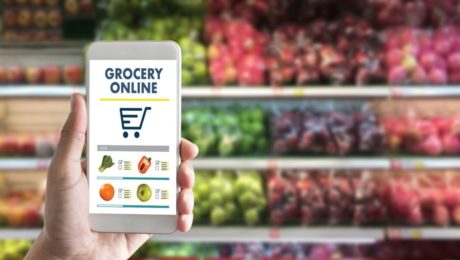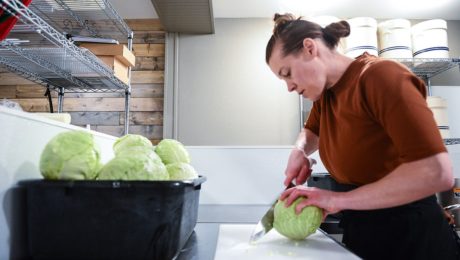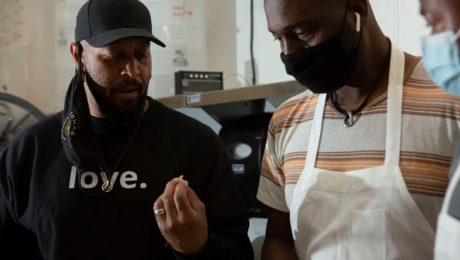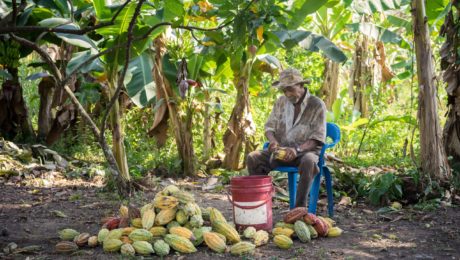A Yeast Primer
Brewers, winemakers and cidermakers are continually on the hunt for the ideal flavor profiles for their fermented beverages. And the key to manipulating those flavors is yeast.
“With beer, you’re taking this kind of gross, bitter soup of sweet barley and hops, and the yeast makes it taste good. Depending on the yeast that gets put in it, it can make it taste like 400 different things, so there’s so much potential there. I think that’s really exciting,” says Richard Preiss of Escarpment Laboratories. Priess was joined by Doug Checknita from Blind Enthusiasm Brewing and Patrick Rue from Erosion Wine Co. to discuss the world of yeast in TFA webinar, A Yeast Primer.
“If you’re invested in vegetable fermentation, yeast might be sort of clouded in mystery and something that is unwanted,” says Matt Hately, TFA advisory board member who moderated the webinar. “It’s what you live by in beverage fermentation in wine and beer and it’s the key to unlocking flavors to make that magic happen.”
Domesticated vs. Wild Yeasts
Just as dogs and cats were domesticated by humans, yeasts have been as well, says Priess, whose company makes and banks yeasts. They are microscopic organisms that adapt, “so if someone’s making beer for over the span of hundreds or thousands of years then the yeast is going to change to kind of get better at fermenting that beer and maybe it’s not going to be so good at surviving out in the wild, just like our toy poodle versus our wolf.”
Other fermented drinks, like wine, sake and cider, use different yeasts with their own specific sets of traits. This is why a wine yeast can’t be used in a beer and vice versa, “though there are some opportunities to experiment.”
Fermenting with wild yeasts has become increasingly in vogue with beer brewers. Aspirational brewers are finding yeasts on the skin of fruit or the bark of trees.
The panelists on the webinar praise experimentation, but note there is risk. Priess says yeasts designed to survive in the wild can be challenging to use in a beer. Checknita points out the safety factor in using yeasts directly from nature as well, “you can get stuff that’s harmful to human health so you have to be careful with your pH levels and what controls there are.”
Traditional winemakers, on the other hand, have long used the wild yeast on grapes to ferment. Rue notes that 10 years ago winemakers began to deviate from this tradition to use pure cultures instead. This process is how many large-scale, industrial producers operate today. But smaller winemakers, who often want to emphasize the specific traits of their terroir, generally use native yeasts and traditional winemaking techniques.
“It’s amazing how wine is how God intended wine to be made because you let nature happen and you’ll probably have a pretty good result with natural fermentation,” Rue continues, “where beer, it’s very touch-and-go, you have to have the perfect conditions and I’ve been able to do spontaneous fermentation with those yeasts.”
The Yeast Family Tree
There’s a large and continually-growing family tree of yeasts, with branches forming for genetic diversity and specialization.
Priess sees three new trends emerging in yeasts: traditional yeasts (like Norwegian kveik) being rediscovered, yeast hybridization (similar to cross-breeding a tomato) and genetic engineering to enhance certain traits of yeast.
“That’s the exciting part of what we’re doing is no one really knows the best approaches to using beer yeast yet, but there’s a lot more new science that’s happening, a lot more brewers that are experimenting, and together we’re collaborating to understand how to work with yeast better and kind of unlock new flavors and new possibilities,” Priess says.
Checknita agrees. He says new yeasts are forming new family trees through spontaneous fermentation, which is taking the base of a beer and experimenting to “push and change those yeasts to do what we want and get that clean flavor that’ll make a beer that tastes good to the human palate.”
- Published in Food & Flavor
The “New Normal”for CPG Companies
Don’t expect people immediately to dump their sourdough starters and crowd restaurants when the Covid-19 pandemic is over. In a U.S. consumer trends survey, 42% of people said they plan to cook more at home post-pandemic. This news is great for Consumer Packaged Goods (CPG) brands.
From record sales to supply shortages to new safety regulations, the retail grocery business was changed dramatically by the pandemic in 2020. But CPG companies experienced phenomenal growth: sales rose over 10% — more growth in one year than in the four-year period from 2016 to 2019. Though pandemic stockpiling (fingers crossed) likely will not recur in 2021 , CPG sales show no signs of slowing down. A mere 7% of Americans said they’d cook less after the pandemic than before. Consumers are buying CPGs more than ever. And they’re not staying loyal to their favorite brands — over 50% of respondents said that they are willing to try different products, and 66% of them stuck with those new brands.
Fermented CPG brands are in a great spot to take advantage of these trends. Healthy foods gained significant share in the food market in 2020. The pandemic propelled fermented food and beverage into the spotlight. More Americans began experimenting with healthier eating during the pandemic, and now they’ve adopted it as a habit.
What does this mean for the future of CPG brands? Here are four ways they must adapt to the “new normal”:
- Sales via Multiple Channels
Consumers won’t be shopping for your products only in brick-and-mortar stores. More consumers than ever are buying through ecommerce. Digital grocery sales were a niche category before the pandemic — now, CPG food and beverage sales are estimated to top $100 billion in 2021.
Food and beverage sales became the largest CPG online segment in 2020.
Direct-to-consumer (DTC) sales also shifted into high gear. Consumers turned to DTC during the pandemic to get their favorite products straight from the manufacturer. Good examples are kombucha producers selling bottles directly from the brewery and a sauerkraut maker shipping to consumers from their kitchen. An analysis by Retail Dive found direct-to-consumer businesses during the pandemic fared better than did traditional brick-and-mortar retailers.
But this doesn’t mean CPG brands should abandon selling in grocery stores.
According to Deloitte’s 2021 Consumer Product Industry Outlook, four out of five companies say “resetting their go-to-market strategy is critical to meeting their objectives; however, only half rated the current maturity of their related capabilities as high.” A majority of CPG companies surveyed say a bigger online and omnichannel presence will be a means of reaching consumers in 2021.
- Conscious Consumption
Consumers want to buy from brands that care about social and environmental issues. Societal inequality and environmental impact are big concerns to many consumers, and they are spending their dollars on ethical brands willing to put their money where their mouth is.
Deloitte found nine in 10 consumers say the pandemic is “an opportunity for large companies to hit ‘reset’ and focus on doing right by their workers, consumers, communities and the environment.” The CPG companies surveyed agree — three in four say establishing such initiatives in 2021 are a “strategy to place purpose alongside profit, express corporate values, and address heightened consumer attention to sustainability, social justice, equality, and environmental consciousness.”
Authenticity is key for proper brand activism. CPG companies need to be transparent with their consumers, integrating their social and environmental purposes into all parts of their business and organization. A brand that acts inconsistently will quickly lose trust with a consumer.
- Preference for Small Producers
CPG sales during the pandemic showed an interesting dichotomy: large companies had the highest dollar growth, but small companies – taken as a whole – gained meaningful share of market. A report by business consulting firm McKinsey & Company found market share of small companies during the pandemic increased from 18.2% in 2019 to 19.2% in 2020, while midsize businesses were flat and large companies fell from 51.2% to 50.5%.
More consumers did switch to new brands during the pandemic, but their primary reason was availability. This area is one where large brands have an advantage, as their greater resources should help them keep products on grocery store shelves.
- Supply Chain Improvements
Whether implementing new safety rules, finding sources with available products or switching packaging materials, every CPG brand had to adjust their supply chain in 2020. They are acting quickly to fix weaknesses exposed by the pandemic, and nine in 10 say they’re making significant progress.
CPG companies used to be praised for holding minimal inventories, but 2020 tested their resilience. Deloitte’s report explains: “Resilience is how companies keep their supply chains from breaking and restore them quickly when they do. It is also how they can gain the nimbleness and scalability to power new go-to-market approaches and innovative business models.”
Barb Renner, Deloitte’s vice chairman and U.S. leader of consumer products, says one of the biggest problems identified in their survey was an over-reliance on a small number of vendors. Most companies didn’t have backup plans. “If they were getting their product from a handful of vendors and one of those vendors had to close down, did they try to find an alternative source?” she asked.
CPG executives indicated supply chain resilience is important or very important for the company in 2021, with nine in 10 saying they are investing in improvements. Beyond creating reliable supply chains that can support their production, CPG companies need to be able to respond to demand and shift supply to new locations.
- Published in Business
Ugly Delicious
A unique business practice has been developed in Montana by Farmented Foods — the company ferments discarded produce from local growers to fill their jars with the likes of radish kimchi, dill sauerkraut and spicy carrot chips. The co-owners (Vanessa Walsten and Vanessa Williamson) met in 2016 at a Farm to Market class at Montana State University. They are currently getting ready to renovate a former cafe into a fermentation kitchen, thanks to a grant from the Montana Agriculture Development Council.
“Every year, so much produce is wasted because we don’t deem it perfect enough,” says Williamson, adding that the company “was founded initially to help farmers eliminate unnecessary food loss on their farms in the form of ugly and excess crops.”
They estimate they’ve saved over 6,000 pounds of imperfect produce.
Read more (Daily Inter Lake)
- Published in Business
Hand-Brewed Makgeolli in South Korea
A beautiful new video from Eater shows traditional makgeolli being made by hand in South Korea. Master brewer Park Bok-soon runs Boksoondoga with her son, where they make this milky, slightly sweet, alcoholic fermented rice drink .
Boksoondoga uses nuruk, a fermentation starter, said to help avoid hangover symptoms, such as headache and upset stomach. Nuruk ferments for about 15 days before being mixed with rice, and then ferments for another 20 days or so in onggis, traditional Korean pottery.
“Hand brewed makgeolli is more delicious when you put your heart into it so that’s how I started making my makgeolli business,” Bok-soon says. “Alcohol is like a drink with living organisms. I love it.”
Read more (Eater)
- Published in Food & Flavor
Vegan Cheese Matures
Vegan cheese makers are “pushing the limits of those fermentations to create … flavors and textures I’d previously thought impossible,” writes The New York Times food columnist Tejal Rao. She says the “new generation” of vegan cheese is surprisingly tastier than the bland, starchy, mass-produced vegan cheese of the early 2000s.
Missing from those first versions of vegan cheese: fermentation, a key to creating flavor. Vegan cheese now is also aged and ripened like dairy cheese to develop flavors and textures.
The microbes used to give cheeses like Gouda and Brie their distinct flavors are also critical. Vegan cheese cultures are now readily available. Aaron Bullock and Ian Marin (pictured), founders of Misha’s Kind Foods, work with proprietary cultures to create cream cheese and ricotta made from cashew milk.
Read more (The New York Times)
- Published in Food & Flavor
Microbes & Chocolate’s Flavor
Love the rich flavor of chocolate? Thank microbes. Scientists are researching how fermentation affects the flavor of chocolate. An article in Scientific American details how a giant cacao seed pod naturally ferments.
Cacao has a wild fermentation, meaning the farmers who harvest the pods “rely on natural microbes in the environment to create unique, local flavors.” Just as grapes take on regional terroir (the characteristic flavor imparted by a place), “these wild microbes, combined with each farmer’s particular process, confer terroir on beans fermented in each location.” Demand for high-quality cacao beans is growing, and producers who make small-batch chocolate with distinctive flavors also are seeing sales growth.
Read more (Scientific American)
- Published in Food & Flavor, Science
Are Cider Clubs Worth it?
In the past decade, more cideries have begun clubs as a way to connect with their customers, keep year-round sales and sell rare ciders.
But during 2020, when the COVID-19 pandemic closed taprooms and cancelled restaurant sales, cider clubs became critical to earn revenue. The American Cider Association (ACA) reported 22% of their members started a club in 2020.
“Our cider club was the one bright spot of 2020. That was really the one thing that kept growing, kept us motivated and got us excited,” says Talia Haykin, founder of Colorado-based Haykin Family Cider. Her products were sold in local fine dining establishments, but those sales evaporated during the pandemic.
“Everyone has kegs they can’t sell during the pandemic,” says Christopher Shockey, who co-authored the book The Big Book of Cider with wife Kirsten (a TFA Advisory Board member). “Cider clubs are keeping them afloat.”
Guaranteeing Sales & Creating Fans
Cider clubs are a subscription service where the cidery ships new, rare, seasonal or limited edition ciders to members multiple times a year. As both online shopping and access to direct-to-consumer alcohol shipping have expanded, subscriptions to cider, wine and other alcohol assortments have become feasible and increasingly popular.
“It’s taking customers who are already excited about you and converting them into a model that’s going to have them buy more from you regularly” says Eleanor Leger, founder of Eden Speciality Ciders. Leger and Haykin shared their tips on cider club growth opportunities during 2021 CiderCon.
“That’s money you know you’re going to have versus just duking it out on the store shelves where a new store manager can just decide they don’t want you and they want somebody else and you lose that shelf space,” Christopher says during the TFA webinar on “The State of the Art of Cidermaking.”
An ACA survey found that cider clubs generate up to 10% of a cidery’s total revenue.
Quarterly shipment of ciders is standard. Haykin and Leger advise cideries to ship more than twice a year, so members won’t forget they joined a club.
“You want to continually remind them that you exist,” Haykin says.
Shipping costs for cider — a fermented product which must be kept cold and is often sold in glass bottles — can be pricey. But, Haykin notes, even though he bears that high cost of shipping : “the repeat business of a club member is worth so much more to us.” Many clubs offer local pick-up to eliminate shipping costs.
Attracting & Keeping Customers
In the crowded alcohol market, cider clubs are a way to differentiate a brand.
While there are not specific stats on the demographics of Americans who subscribe to alcohol clubs, product subscription services overall are rapidly growing. Millennials are the dominant users of subscriptions — 31% currently have one or more, and another 38% say they will in the next six months.
Cider sales grew 9% in 2020, and they represent 11% of the craft beer category (where cider sales are tracked). Wine is struggling with Millenial and Gen Z consumers, who view it as a drink for an older demographic. Kirsten Shockey says younger consumers gravitate to cider instead.
“People are looking for funky flavors,” she adds. “I think the biggest battle cider makers have is feeling like the wine cooler crowd is their crowd. But that is changing, people are looking for more flavor.”
Member offerings vary for cider clubs, and can include:
- Discount on tap room products.
- First chance to try new items.
- Exclusive taproom tastings.
- Forage days (members help pick cider apples from local orchards).
- Volunteer opportunities at local farmers markets and food festivals.
The No. 1 reason people cancel a membership is because of a bad experience. Haykin stresses the importance of responding to a customer within, at most, 12 hours. “Communication is one of the most important things you’ll offer as a club,” she says.
Leger adds: “We jump all over someone who has had a problem to make sure they know we are sorry and we take care of it right away. Handling a problem really well creates incredible loyalty. People can be out there building your brand for you because they love you and they’re telling all their friends. If they have a bad experience, they’re destroying the brand for you.”
- Published in Business
Fermented Foods Fighting Food Insecurity
Fermenti Foods has teamed up with a local salt producer to help food insecurity in their local county of Madison County, North Carolina.
Meg Chamberlain (pictured) donates jars of her fermented kraut and carrots to the Beacon of Hope Food Bank. She’s also helped the food bank preserve fresh food donations. And now she’s adding recipes for sauerkraut and tutorials on YouTube. Chamberlain says fermentation is a useful tool for home preservation.
“In addition to the fact that more people are growing, they need to know what to do with what they’re growing in their gardens,” she said.
Read more (Citizen Times)
Zilber on Leaving Noma for Bioscience Corporation
A sustainable food industry will be built by flavor, says David Zilber, noted chef and food scientist.
Zilber made major headlines and surprised many in October when he left his job as head of the fermentation lab at Noma for a food scientist position at Chr. Hansen, a global supplier of bioscience ingredients. Noma, a two-Michelin star restaurant in Copenhagen, Denmark, has been regularly ranked one of the best restaurants in the world. In 2018, Zilber co-authored a bestselling book on fermentation with Noma co-owner Rene Redzepi.
In an Instagram live interview last week with Al Jeezera’s Femi Oke, Zilber elaborated on why he traded an apron for a lab coat. The global food system, Zilber says, is unsustainable. Waste is prevalent, food is created with long footprints, agricultural production is shrinking, meat is heavily consumed and large corporations control the industry.
Transforming Vegetables
“What I’m trying to do in my work is to make vegetables as God damn tasty as they can possibly be by using microbes, using things that are already at our disposal, and convincing people that this might have to have a little bit of a longer inventory life while you let it ferment, while you build a stockpile, but this is the result, this is why you’ll be able to convince people why eating this way is healthy for them and the planet,” he says. “Flavor is king.”
Ingredients created by Denmark-based Chr. Hansen (the company has 40,000 microbial strains used as natural ingredients) feed 1-1.5 billion people a day. These include microbes in yogurt and yeast in beer.
“I work with them to try and make the food system more sustainable, to get more people eating vegetables,” Zilber says, adding that 30% of every calorie consumed by humans is fermented by bacteria, microbes or fungus. “No matter what we eat in the future, that’s still going to be the case. That slot of the human diet still needs some form of microbial transformation, whether it’s meat or dairy or oat milk or peas. I work to figure that out.”
It’s a different philosophy compared to the food technology many new companies are utilizing to create alternative proteins like Beyond Burger. He complimented the company for their high standards, but he says a Beyond Burger patty is not a replacement for a juicy, beef burger. People pay more for an inferior eating experience.
“At the end of that day, that will not cut it,” Zilber says. “Why does food have to be that processed to be purportedly that delicious? With some skilled tricks in the kitchen, with some ninja jiu jitsu behind the stove, you can make vegetables really, really delicious.”
Sustainable Food Systems
A sustainable food system will look much like one from 300 years ago, Zilber hypothesizes. It will be localized, where people purchase food produced close by. Modern practices of shipping ingredients and processed food around the globe are harmful to the environment.
“A truly sustainable food system looks far more decentralized than [the current one] does right now. There are [only a] very few stakeholders that are responsible for really a lot of calories,” he continues.
Oke questioned how Zilber could change a broken food system controlled by large companies when he now works at one of the major companies.
“If you want to be an idealist, that’s great, you might end up being a martyr,” Zilber says. “Sometimes you have to work within those contradictory institutions to try to do as much good as possible.”
Restaurant Industry’s Responsibility
The restaurant industry plays a part in it too, Zilber says. Workers are stretched thin, overworked, underpaid “and then extremely vulnerable in a time of crisis.” The pandemic has exposed and highlighted these problematic parts of the restaurant business.
Zilber says there are still too many restaurants. It’s hard to find good cooks, and staff is often undertrained.
“I took a step into food production myself. Maybe more of these cooks, more of these people who are passionate about food, need to consider options beyond just the restaurant setting and see value in becoming a farmer, becoming a distributor, becoming someone who decides how those calories are made because restaurants aren’t the full picture of the food system,” he continues. “There are a lot of talented people within it who know food, who understand it, who understand the human experience of what it means to make good tasting food and satisfying food. There’s other places for them to work as well.”
- Published in Business
Are Fermented Foods Probiotics?
Probiotics and fermented foods are not equivalent, says Mary Ellen Sanders, PhD and executive science officer of the International Scientific Association of Probiotics & Prebiotics (ISAPP). She advises fermented food producers that don’t meet the criteria of a probiotic to use descriptors such as “live active cultures” or “fermented food with live microbes” on their labels rather than “probiotic.”
“There are quite a few differences between probiotics and many fermented foods. You cannot assume a fermented food is a probiotic food even if it has live cultures present,” says Sanders. She highlighted her 30 years worth of insight into the field during a TFA webinar, Are Fermented Foods Probiotics?
Some fermented foods do meet these criteria, such as some yogurts and cultured milks that are well-studied. But many traditional fermented foods do not.
Using multiple peer-reviewed scientific studies and conclusion from expert panels in the fields of probiotics and fermented foods, Sanders shared the ways in which fermented foods and probiotics differ:
- Health benefits
By definition, a probiotic must have a documented health benefit. Many fermented foods have not been tested for a health benefit.
“If you are interested in recommending health benefits from a fermented food in an evidence-based manner, many traditional fermented foods fall short. They don’t have the controlled randomized trials that will provide a causal link between the food and the health benefit,” she says. “A food may be nutritious, but probiotic benefits must stem from the live microbe, not the nutritional composition of the food. Otherwise you just have a nutritious food that happens to have live microorganisms in it. You don’t have a probiotic food.”
- Quality studies
In her presentation, Sanders shared multiple randomized clinical trials on human subjects with supported health evidence for probiotics. But there are few randomized, controlled studies on fermented foods. Most are cohort studies, which inherently have a higher risk of bias and cannot provide a causal link between consuming fermented foods and a health benefit.
“A strong hypothesis is not the same as proof,” Sanders says. “Evidence for probiotics must meet a higher standard than small associative studies, many of which are tracking biomarkers and not health endpoints.”
She noted, though, there are some studies on fermented milk and yogurt that show a conferred health benefit.
- Strain designation
Though many fermented foods do have live microbes, a probiotic is required to be identified to the strain level. The genus and species should also be properly named according to current nomenclature. Many fermented foods contain undefined microbial composition. Without that strain designation, one can’t tie the scientific evidence on that strain to the probiotic product.
- Microbe quantity
Another key differentiator is that probiotics must be delivered at a known quantity that matches the amount that results in a health benefit. Probiotics are typically quantified in colony forming units (or CFUs).
“A probiotic has a known effective dose. But fermented foods often contain unknown levels of microbes, especially at time of consumption,” Sanders says.
What Can Brands Do?
If food brands keep using the word probiotics as a catch-all to describe a fermented product, the term will lose its utility. Using “probiotics” on food with unsubstantiated proof of probiotics is a misuse of the term.
“When I see a fermented food that says probiotics on it, I very often think what they’re trying to communicate on that label [is that it] contains live microbes,” Sanders says, “because I’m doubting, at least some of the products I see, that they have any evidence of a health benefit. And so they’re just looking for a catchy, single word that will communicate to people that this has live microbes in it. ‘Live active cultures’ is something that resonates with people as well. So why not use that?”
Sanders encourages fermented brands to standardize the terms “live active cultures,” “live microbes,” “live microorganisms” or “fermented food with live microbes.” For products pasteurized after fermentation, there’s a term for them too: “Made with live cultures.”
Controlled human studies on fermented foods can be challenging, Sanders admits. Such studies can be difficult to properly blind, since placebos for foods are hard to design. The fermentation process affects the product taste so that study subjects may know what they are consuming. But the health benefits of fermented foods could be studied, though. She also advises producers to focus on the nutritional value of their food.
“That’s one thing that really has me excited about this concept of core benefits,” says Maria Marco, PhD, professor of food science and technology at University of California, Davis (and a member of TFA’s Advisory Board) and moderator of the webinar. “I think it kind of opens the doors to the possibility of fermented fruits and vegetables where there’s certain organisms, microorganisms that we’d expect to be there but again we need to know really if those microorganisms are needed to make those foods healthy.”










